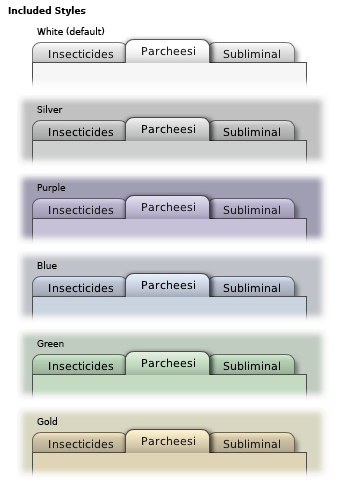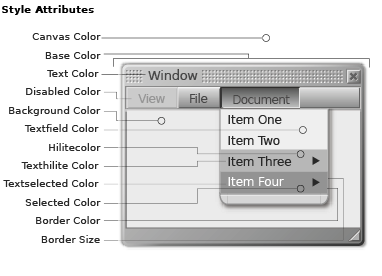OpenLaszlo
| OpenLaszlo
|
|
|---|---|

|
|
| Basic data
|
|
| developer | Laszlo Systems |
| Current version | 4.9.0 (October 21, 2010) |
| operating system | Cross-platform |
| programming language | Java |
| License | CPL |
| www.openlaszlo.com | |
OpenLaszlo is a discontinued platform for the creation of Rich Internet Applications . The system previously developed under the name Laszlo Presentation Server by the Californian company Laszlo Systems was released as free software on October 7, 2004 under the Common Public License .
description
OpenLaszlo is a server-based declarative development environment that enables developers to create Rich Internet Applications (RIAs) on the fly . The developer uses a text editor to edit the content of an LZX file that is on the server. With the browser, the developer calls up this file from his OpenLaszlo server and optionally gets a Flash or DHTML dialog displayed in his browser. The user of the application also calls up the page and uses the website transparently as an RIA application.
OpenLaszlo uses the same principle as Flex from Adobe Inc. , whereby OpenLaszlo was on the market with the product idea years before Adobe. It wasn't until Macromedia began to develop Flex that the originally proprietary product “Laszlo” became a free product “OpenLaszlo”. The Rich Internet Applications are written in a separate XML language called LZX. LZX - an XML language similar to XAML - is based on a mixture of XML tags and ECMAScript code. These LZX files are then translated "on-the-fly" into Flash byte code using Java (for example Tomcat server), which is then executed by the Flash plug-in of the web browser. Alternatively, so-called SOLO applications can also be translated and exported, which can be integrated into websites as independent .SWF files or DHTML code. From version 4.7 it is possible to create either SWF files (Flash 8/9/10) or DHTML. No changes to the source code have to be made on the server side. The strategy of the open source project is to remain as manufacturer-independent as possible with the application “player”. Further player types are in preparation.
OpenLaszlo aims to simplify and accelerate the development of front-end applications compared to conventional development. OpenLaszlo is a declarative development environment based on an XML dialect (LZX) and a Java-based generator. There is a separation between design (layout draft, skinning, visual components) and the program logic (event handling and backend connection). Various mechanisms are supported to simplify development, such as the automatic updating of DataGrids when data changes. Either the OpenLaszlo Servlet (J2EE Deployment) or data sources installed on a web server (SOLO Deployment) serve as the backend. B. in PHP, JSP etc. or as static files (XML, FLV etc.).
Declarative development
OpenLaszlo released the first OpenLaszlo server in 2002. This made it possible for the first time to develop a web interface using a declarative language. In declarative development, the developer first creates a visual framework, adds elements and finally connects the user interface elements with the backend data sources.
Development environment
A free development environment (IDE) was also published as part of the open source project. The OpenLaszlo IDE is based on Eclipse and offers the option of editing LZX files. This topic is currently no longer pursued. In addition to the IDE, however, there are other open source projects and commercial products.
The following examples show how a surface can be created:
Hello world! (LZX)
<canvas width="200">
<text>Hello World!</text>
</canvas>
Output:
Hello world! (ECMAScript)
<canvas width="200">
<script>
var text = new LzText();
text.addText('Hello World!');
</script>
</canvas>
Output:
Window example
<canvas width="200">
<window x="10" y="10"
width="150" height="150" >
<button>Hello World!</button>
</window>
</canvas>
Output:
Components
To create your own application, you can fall back on the selection of standard components, change them (skinning, appearance and other) or develop your own components.
Output formats
- Flash (swf8, swf9, swf10)
- DHTML
Current development
It is unknown how the development of future versions of OpenLaszlo will progress. However, there are some indications that the development stopped some time ago. The last official communication took place at the end of 2012, when the Nightly Build Version 5.0b2 was made available for download. However, download of any kind (documentation, official version, nightly builds) has not been possible for an unknown time without the manufacturer having responded to the relevant information. Laszlo Systems was acquired by CP (now Openwave Messaging ) at an unknown date .
In 2017, enthusiasts can only access a documentation archive at the old web address openlaszlo.org.
Web links
- Introduction to Laszlo
- Openwave Messaging (current owner of Laszlo Systems)
Individual evidence
- ↑ The openlaszlo Open Source Project on Open Hub: Languages Page . In: Open Hub . (accessed on September 26, 2018).
- ↑ Announcement Milestone Release 5.0b2 . Laszlo Systems. November 30, 2012. Archived from the original on October 4, 2013. Info: The archive link was automatically inserted and has not yet been checked. Please check the original and archive link according to the instructions and then remove this notice. Retrieved September 21, 2014.
- ↑ OpenLaszlo dead? . OpenLaszlo Forum. January 5, 2014. Accessed on September 21, 2014. ( Page no longer available , search in web archives ) Info: The link was automatically marked as defective. Please check the link according to the instructions and then remove this notice.



